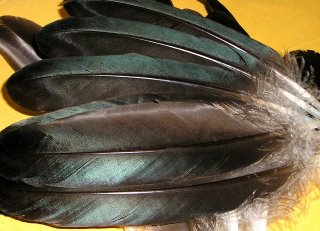 Let me begin by acknowledging that I have been more than remiss in my blogging. I have many good and valid reasons, but I won't bother trotting them out, because I know everyone can produce a "good" excuse when she needs one, and the rest of us don't think too much of it.
Let me begin by acknowledging that I have been more than remiss in my blogging. I have many good and valid reasons, but I won't bother trotting them out, because I know everyone can produce a "good" excuse when she needs one, and the rest of us don't think too much of it.OK, then, let's talk about ducks. (This one's for you, Lynne.) We have been wading through duck feathers for a couple of weeks now. I can't seem to find a reliable source of information that can tell me how much longer this may last, but it seems to be somewhere between two more weeks and maybe next November.
In the meantime, I pick up several dozen discarded feathers a day, with hundreds more passed by. Our three older ducks (that would be Basil, Macrina and Petra) are molting.
Oh, boy, are they molting.
I've never experienced this before (nor have these particular ducks), and I am definitely impressed. Everything else in duck life is put on hold in the effort to be decked out in a new feathery spring outfit: no eggs, no wandering about the neighborhood, no mating ... just feather-dropping and feather-making. Though I admit I don't really see much evidence of that feather-making part just yet.
It's really sad.
The ducks are looking shabby; everything from the teeniest pin feathers to impressive wing- and tail-tips are scattered around the yard and in the duck houses. Looks like a major pillow fight happens daily out there. All three ducks wander about with little feathers hanging on by a thread and bigger ones hanging off their bodies every which way.
It never occurred to me that some (all?) birds need to change clothes every year or so, and that it takes a humongous effort to do it.
I pick up the least damaged feathers and look at them carefully. The big female feathers are half brown and half blue-green-gold, separated by a deep burgundy quill. On one side of their body the shiny part is on the right side of the feather; on the other side of the body, it's on the left. The feathers arc in opposite directions, too. The base of every feather begins with about 1/2" of boa-like wisps, soft and fluffy shafts that curl and float in every direction. Then, suddenly, perfectly formed shafts "glue" themselves to each other and form the part of the feather we recognize as "feather".
Hunh. Never noticed that before.
I've also discovered that each duck has an extensive feather inventory—from 1/2" to 10" long, each an exactly formed feather, from boa-fluff to tip. Needless to say, no two feathers are exactly alike. Makes you wonder how a duck looks coherent, doesn't it?
But if we were to take such a careful look at any creature, whether bird, mammal, insect, rock or brussels sprout, we'd discover similar characteristics. Now that is amazing. All our pieces-parts are quite individual and completely unique, yet when viewed as a whole, a bird is percieved as a bird, not as a conglomeration of a few thousand feathers; a lion is a lion, not a bunch of different kinds of hair and nails and teeth; a mountain is a mountain, not a scree field here, a schist out-cropping there ...
Think about it. Doesn't that just make your jaw drop in wonder?


1 comment:
Yes, it is amazing. Now, why can't we as thinking creatures celebrate our own uniqueness as well as our similarities?
Post a Comment